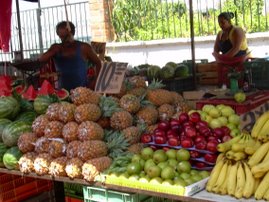So, as the heat of May continues, we are seeing more signs that the rain is coming soon. The “RainBirds” we hear in the morning and evenings as they squeal and announce the coming of the rain. They are really insects, not birds, and the Mexican folklore says that it will rain six weeks after the rain birds start their songs. We’ll see. The important thing is that the rains will come, turning the hillsides green and cooling the days once again.
We have had a number of events which provide some photos for this post. The Ajijic Garden Club has completely redone the garden at the Wilkes Biblioteca, or library, where the ESL classes are held. The gardens there were very poor, and the Garden Club worked hard to re-landscape and plant new plants to create a much more peaceful space for the students. Our UU friends, Sharon and Bebe, are members of the club and invited us to a reception to celebrate the new garden. Here are some photos. The first photo is of our friends Sharon (right) and Kenya:
Another big event related to the ESL program is the annual recognition for all the students. My student, Francisco, in addition to our lessons, completed the level one instruction and I attended his recognition ceremony last week. Here are some photos. The bottom photo is of Francisco with his dad, Teo:
We are members of a movie group here. We have five couples (and one has their daughter living with them) who, every month or two, host a movie and then serve dinner to everyone. It was our turn to host, and, with our small living room, we had difficulty imagining how we could seat eleven people for a movie and then serve dinner comfortably. We thought outside the box and decided to use our pool-barbeque area for both the viewing of the film and dining area. It involved hauling the TV down to the pool area and carting down all the food, but it was a great success. Here are some photos of the movie seating and the dining:
One of our Great Book Discussion partcipants, Suzanne, had foot surgery and had limited mobility, so we held the last two meetings at her house. Her house is an amazing, very Mexican, hacienda. I had to take some photos to share with you:
We had another dinner with our old neighbors, Ron and Pat and Wayne and Claudette. Ron and Pat had a couple from Montreal visiting them again this year, Rick and Joanne. We had met them last year and were glad to see them again. Here they are posing with Chuy:
In the local newspaper this week, there was an article about gas prices in Mexico. The government is raising the price each month, but it still is cheaper than in the US. The present price for Magna (regular) is 9.16 pesos per liter, or equivalent to $2.89 per gallon.
In another article, the Municipality of Chapala has finished drilling a new well for Riberas, the town where we used to live. They claim it will solve the lousy water problem we had there… we’ll see.
We have had no serious violence here in the Lake Chapala area…good news. Life is hot, but good!
































































































